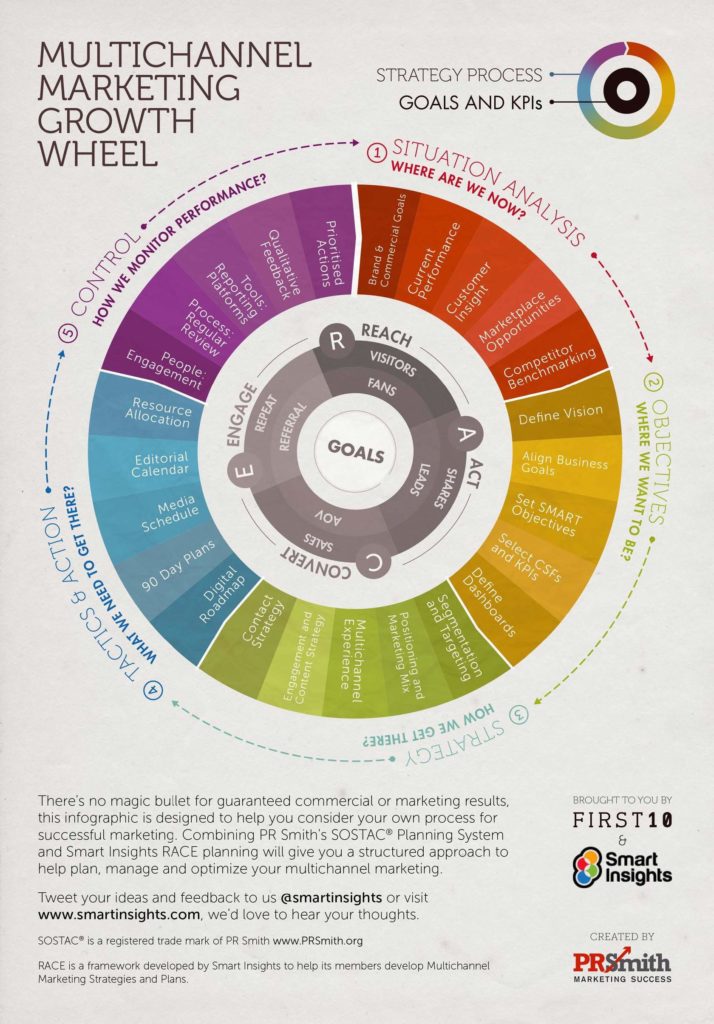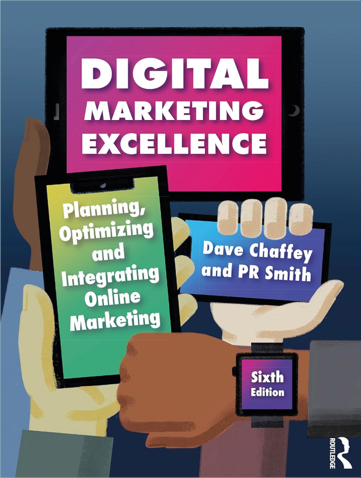I have featured PR Smith’s SOSTAC® Planning framework (explained more fully at Paul’s site: www.sostac.org) in all of my books on digital marketing strategy since it provides a simple, process-based structure for creating any form of marketing plan that can be readily communicated to others. Thanks to its simplicity and effectiveness for planning it has been widely adopted in organisations of all sizes as a method of structuring marketing and other plans. It was rated as one of the most popular marketing models in a poll of marketers organised by the Chartered Institute of Marketing.
The SOSTAC® framework was originally created by UK-based marketer PR Smith in the 1990s and was applied to digital marketing our book Digital Marketing Excellence from the early 2000s when businesses were first working out how to develop digital marketing strategies.
I created this wheel infographic of SOSTAC® to summarize common activities for creating a multichannel / digital marketing communications plan in 2017, it’s based on a more generic marketing growth wheel developed by Dan Bosomworth and I in 2012.

What is SOSTAC® planning?
SOSTAC® has six steps; it stands for Situation, Objectives and Strategy, Tactics, Action and Control. Here I relate it to the chapters of my Digital Marketing: Strategy and Implementation book (authored with Fiona Ellis-Chadwick).
1. Situation analysis means ‘where are we now?’
Planning activities involved at this stage include performing an digital-specific SWOT analysis, and reviewing the different aspects of the micro-environment (Chapter 2) including customers, competitors and intermediaries. Situation analysis also involves review of the macro-environment (Chapter 3).
2. Objectives means ‘where do we want to be?’
This can include a vision for digital channels, and also specific numerical objectives for the digital channels such as projections of sales volumes and cost savings (see Chapter 9).
3. Strategy means ‘how do we get there?’
Strategy summarises how to achieve the objectives for the different decision points explained in this chapter, including segmentation, targeting, proposition development (including the elements of the marketing mix described in more detail in Chapter 5 and CRM described in Chapter 6).
4. Tactics define the usage of tactical digital and traditional communications tools?
This includes specific details of the marketing mix (Chapter 5), CRM (Chapter 6), experience (Chapter 7) and digital communications (Chapters 8 and 9).
5. Actions refers to action plans, change management and project management skills?
We refer to some of the issues of modifications to organisational roles and structures in chapter 4.
6. Control looks at the use of management information including web analytics to assess whether strategic and tactical objectives are achieved and how improvements can be made to enhance results further.
This is closely related to goal setting as described in this chapter and in Chapter 8, and also the coverage of web analytics and tracking in Chapter 10.
Note that each stage is not discrete; rather there is some overlap during each stage of planning – previous stages may be revisited and refined, as indicated by the reverse arrows
Why use SOSTAC® planning?
I recommend SOSTAC® because it provides a clear structure, that is simple to remember and to explain to others that covers all the stages needed to create AND implement any type of business or marketing plan.
The framework:
- Is based on what’s happening in a company’s marketplace, i.e. it’s customer-centred and reviews the importance of potential partners, influencers and competitors (in situation).
- Has clear objectives to achieve a vision for the future – particularly important for digital marketing (in Objectives).
- Gives clear strategic direction and focus to achieve your objectives (in Strategy).
- It summarizes the marketing techniques to be used to achieve your Strategy (in Tactics).
- Has a method of tracking and review to keep the strategy on track when you’re implementing it (in Actions and Control).
Integrating SOSTAC® and RACE
This is a common question that this video explainer answers.






